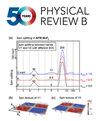Machine learning accelerated discovery of superconducting two-dimensional Janus transition metal sulfhydrates
IF 3.7
2区 物理与天体物理
Q1 Physics and Astronomy
引用次数: 0
Abstract
The MoSH monolayer, one of the Janus transition metal sulfhydrates synthesized by stripping the top-layer S of and replacing it with H atoms [Wan et al., ACS Nano 15, 20319 (2021)], has been predicted to host strong coupling two-gap superconductivity with a calculated critical temperature of about 28.58 K at atmospheric pressure. In this work, by using machine learning aided high-throughput calculations, we narrow down 180 possible configurations of two-dimensional Janus transition metal sulfhydrates ( monolayers, where metal group elements and , Se, and Te) to 20 stable metals. Among them, we identify six low-energy monolayers that are potential high- superconductors. Notably, the -TiSH monolayer stands out with the highest of approximately 48 K, surpassing the superconducting properties of -MoSH ( K) and the well-known superconductor ( K). By solving the anisotropic Migdal-Eliashberg equations, we find that -TiSH naturally exhibits a one-gap superconducting nature with strong electron-phonon coupling () originating from the interactions of Ti orbitals and in-plane vibrations, which is different from and better than the -MoSH monolayer (). The presented results enrich families of Janus transition metal sulfhydrates and accelerate the design of novel two-dimensional superconductors.

机器学习加速发现超导二维贾纳斯过渡金属硫化物
MoSH单层是通过剥离MoS2的顶层S并用H原子取而代之而合成的Janus过渡金属硫化物之一[Wan等人,ACS Nano 15, 20319 (2021)],据预测,MoSH单层具有强耦合双间隙超导性,常压下的计算临界温度Tc约为28.58 K。在这项工作中,我们利用机器学习辅助高通量计算,将二维 Janus 过渡金属硫化物(MXH 单层,其中 M=过渡金属族元素,X=S、Se 和 Te)的 180 种可能构型缩小到 20 种稳定金属。其中,我们发现了六种潜在的高锝超导体低能单层。值得注意的是,1T-TiSH 单层具有最高的 Tc(约 48 K),超过了 1H-MoSH(Tc=28.58 K)和著名的 MgB2 超导体(Tc=39 K)的超导特性。通过求解各向异性的 Migdal-Eliashberg 方程,我们发现 1T-TiSH 自然表现出单隙超导性质,其强电子-声子耦合(λ=2.79)源于 Ti dxz、yz 轨道和面内振动的相互作用,这与 1H-MoSH 单层(λ=1.60)不同,且优于 1H-MoSH 单层(λ=1.60)。这些结果丰富了 Janus 过渡金属硫化物家族,并加速了新型二维超导体的设计。
本文章由计算机程序翻译,如有差异,请以英文原文为准。
求助全文
约1分钟内获得全文
求助全文
来源期刊

Physical Review B
物理-物理:凝聚态物理
CiteScore
6.70
自引率
32.40%
发文量
0
审稿时长
3.0 months
期刊介绍:
Physical Review B (PRB) is the world’s largest dedicated physics journal, publishing approximately 100 new, high-quality papers each week. The most highly cited journal in condensed matter physics, PRB provides outstanding depth and breadth of coverage, combined with unrivaled context and background for ongoing research by scientists worldwide.
PRB covers the full range of condensed matter, materials physics, and related subfields, including:
-Structure and phase transitions
-Ferroelectrics and multiferroics
-Disordered systems and alloys
-Magnetism
-Superconductivity
-Electronic structure, photonics, and metamaterials
-Semiconductors and mesoscopic systems
-Surfaces, nanoscience, and two-dimensional materials
-Topological states of matter
 求助内容:
求助内容: 应助结果提醒方式:
应助结果提醒方式:


